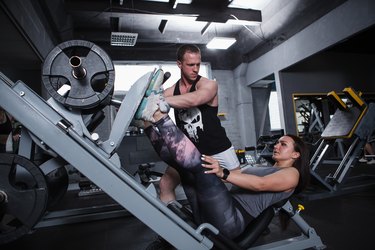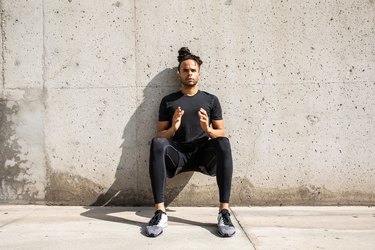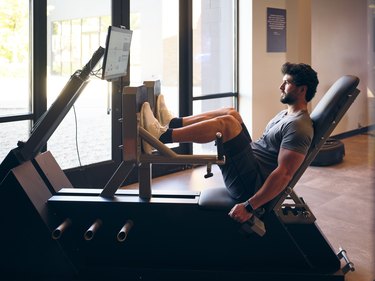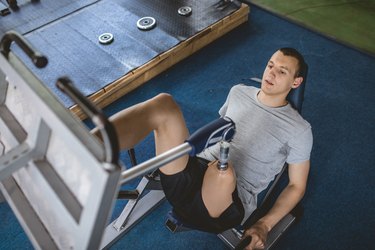
The leg press is much more than just a squat alternative. It's a powerful machine that lets you load up on leg day without worrying about balance and without a barbell on your back.
It's also a great option for building the lower body if you have joint issues. Harvard Health Publishing recommends the leg press as a squat alternative to help avoid stress on the knees.
Video of the Day
Video of the Day
And by changing variables about how you do the leg press, you can alter the focus of the move on your different leg muscles, says Jarrod Nobbe, CSCS, head weightlifting coach for the Athletic Lab weightlifting team.
"That's one of the things that's kind of fascinating about the leg press," he says. "You can move your feet just a little bit, and completely change the muscle groups that you're targeting."
If you're yearning for burning quadriceps or keen on growing your glutes, here's how to employ small changes on this classic leg machine to achieve new, different results.
Don’t Worry About Foot Width or Angle
While changing the height of your feet on the plate of the leg press (toward the plate's top or bottom) can impact which muscles you'll tax more during the movement, the width of your feet and the angle of toes (parallel or in a "v" shape) doesn't seem to have much impact, according to two different studies.
The first, an often-cited September 2001 study in Medicine and Science in Sports and Exercise, tested exercisers with nine or more years of experience on the leg press, and compared different variations of the movement: hip-width foot placement versus twice as wide, and with toes pointed straight ahead versus angled out at 30 degrees. The result: Width and angle had almost no impact on how hard the leg press worked the quadriceps, the prime mucles in the exercise. Widening the feet increased activity in the hamstrings, but only a little.
A study in the May-June 2022 issue of Sports Health confirmed those results: Foot width and angle had no significant impact on muscle activity during the leg press. So instead of forcing your feet into a width or angle that you think is "better," choose one that is comfortable for you to complete the exercise.
What did matter in the 2022 study: How hard the exercisers pushed during the weight during the concentric, or leg-straightening, portion of the movement. When the study participants pushed the weight as hard and fast as they could, they had greater muscle activation than when they pushed the weight for a controlled, two-second concentric portion of the repetition.
Another study, from the November 2020 issue of International Journal of Environmental Research and Public Health, found that for young women on the leg press, pushing the weight hard and fast in this way doubled muscle activation compared to pushing the weight up under a controlled, two-second pace.
So when pressing the weight up from the bent-knee position to the straight-leg position, do it with gusto! You'll increase activity in all the muscles you're trying to target on the sled.
Glutes and Hamstrings: Move Your Feet Higher on the Plate and Go Deep
Lower-body lifts are often divided into two categories: Knee-dominant movements (like squats, lunges and step-ups) primarily flex the knee joint. While these exercises also work the hamstrings and glutes, knee-dominant movements primarily develop the quadriceps, the muscles in the front of your thighs that act to straighten your knees.
Deadlifts, good mornings and hip thrusts, on the other hand, are hip-dominant movements: They primarily flex the hip, and so they primarily develop the muscles that straighten and flex the hip, which are the glutes and hamstrings.
The leg press is usually a knee-dominant movement, like a squat. But by moving your feet higher on the sled's foot plate, the exercise becomes more of a hip-dominant movement, says Greg Pignataro, CSCS, owner of Never Past Your Prime. In this variation, the degree of both hip flexion and extension are increased, and the range of motion at the knees is reduced.
Placing your feet up high also puts more of the weight into your heels, says Nobbe, and thus into the backs of your legs, where your hamstrings and glutes are.
"This is like if you were doing an RDL [Romanian deadlift], and you raised your toes two to three inches off the floor. You're actually going to feel much more lengthening in the hamstrings and the posterior chain than if your feet were flat on the floor," he says, because more weight is on your heels. Moving your feet up on the leg press sled does the same thing.
Both coaches agree: The effect is more pronounced on your glutes than your hamstrings.
"In general, the leg press is not a great way to work on the hamstrings. It's more of a passive byproduct, a small engagement, instead of the point of the exercise," Pignataro says.
To increase the stress on your hamstrings, Nobbe suggests lowering the weight slowly before pressing up in the fast, forceful way described above.
"The hamstring is really good at loading eccentric forces really well," he says. Translation: The hamstrings excel at braking — when you land from a jump or lower in a squat, your hamstrings absorb that weight and allow you to control yourself. Slowing down the eccentric (lowering) portion of the leg press puts more stress on the hamstrings, and can increase their activation.
To turn up the glute activation, Pignataro says, reduce the weight so that you can lower the sled as far as possible.
"To target the glutes, get the sled as close as possible to your body so that you're in maximum hip flexion," he says. "When your hips are bent the most, that's when the glutes are going to be stretched the most, and that's where you'll get them working the hardest."
How to Do It
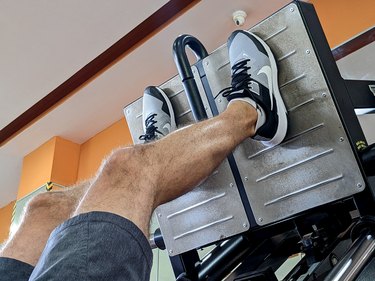
1. Choose a Lighter Weight Than Normal
This is true for all leg press variations and deviations, Nobbe says. The leg press, he says, is a machine where exercisers are used to loading lots of plates on the side. But when moving your feet to a new position, you're learning a whole new exercise — so you need to be careful not to injure yourself during the learning phase.
"It's always easier to add more weight in the next set," he says, than trying to muscle through a weight that's beyond your capabilities.
Keeping the weight light will also allow you to bring your knees closer to your chest, Pignataro says, where you can maximize hip flexion and glute recruitment. Getting your hips into a full flexion position may also put your back into a bit of a curved position, and overloading your back in that way is a recipe for injury. So keep it light.
2. Move Your Feet Up a Little at a Time
If you're used to having your feet in the center of the leg press foot plate, don't immediately move your feet to the very top of the plate.
"Start from smack dab in the middle, then move your feet up one-quarter of the length of your foot," Pignataro says. Perform a set with your feet in this position, and see what you feel. "See if you can be in touch with your body, and notice the difference in sensations — do you feel it more in the glutes and hamstrings?"
If moving up this much gives you more sensation in the muscles in the backs of your legs (and you're not feeling pain or discomfort) it's working, he says. Try moving your feet up a little more. But don't go beyond a point where you start to feel pain or discomfort.
3. Slow Down, Go Deep
Maximize your hamstring activation by performing a slow eccentric (lowering) portion of each rep, as Nobbe suggests.
And keep going down as far as you comfortably can, Pignataro says, to further stretch your glutes and thus increase the amount you need to flex them to straighten your legs back to the starting position.
If you're worried about rounding your back too much, lower your legs at least past a 90-degree knee angle to start involving your glutes, he says. Just as with squats, your glutes won't really get involved in the leg press until you go this deep.
4. Focus On Glute Contraction as You Press Up and Finish
If you want to emphasize your glutes, don't just move your feet — move your mind, Nobbe says.
"If you don't finish with the intent of squeezing your glutes and emphasizing the hip extension at the top, you're missing out on training the glutes, and on strength and power development," he says. As you press the weight, focus on how the movement feels in your glutes, and at the top, give your butt cheeks a squeeze and fully extend your hips.
Quads: Move Your Feet Lower on the Plate
Just as raising your feet puts more weight on the heels (and thus the back of the legs), sliding your feet down on the foot plate increases weight on your forefoot, Nobbe says.
"It's like if you did a heels-elevated squat. Then our foot pressure is more on our toes," he says. "You're going to get more anterior [front side] loading, and you're going to get more quadriceps activation."
How to Do It
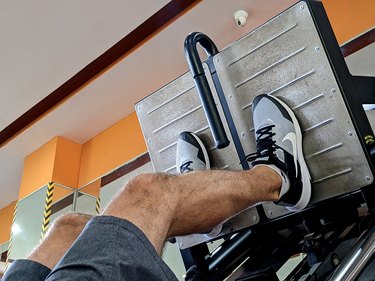
1. Choose a Lighter Weight Than Normal
Moving your feet down makes the leg press more knee-dominant, which doesn't just mean it trains the muscles around the knee, but also places more stress on the knee joint itself, Pignataro says. So if you're going to amp up the quad activation by moving your feet lower on the plate, be careful.
"Drop the weight, and start very light," he says. Make sure the new foot position does not create pain or discomfort in your knees.
2. Move Your Feet Down a Little at a Time
Pignataro's advice here is the same as when moving your feet up: Start in the middle, and move your feet down one-quarter of the length of your foot in each subsequent set, looking for a location that doesn't hurt while simultaneously taxing your quads.
That location on the plate will be different for everyone, he stresses: "You are a lifelong experiment of one," he says. "Due to everybody's differences in height and size and torso thickness and more, going all the way to the top or bottom of the plate might be comfortable for one person, and dangerous for another. Find the position that's comfortable for you, and don't work through pain — ever."
Calves: Calf Raise on the Leg Press with a Big Stretch
One of the most popular uses for the leg press isn't for leg pressing at all, it's for calf raises. By positioning your feet at the bottom of the plate with part of each foot hanging off, you can press the weight up using your forefoot while your legs remain nearly straight.
Many exercisers can actually calf raise more weight than they can leg press, Pignataro says. That's partially because our calves have great leverage, but it's also because we're constantly exercising them.
"We get a little bit of calf work from every step we take. But it's all from that neutral ankle position," Pignataro says, where your foot starts flat, then moves up to your toes. Many gym-goers, he says, also do their calf raises this way.
But bringing your toe up toward your shin, a position called ankle dorsiflexion, puts your ankle and calf in a weaker position, so you can gain more strength and calf size, he says. "We almost never exert force in this dorsiflexed position. We're just not used to it," so it's a bigger challenge.
Another way to change the challenge, Nobbe says, is by altering the width of your feet and the bend in your knees. A wider stance, he says, will challenge the sides of the calves more, while a more narrow stance will tax the middle of the muscle group.
"Where I tell people is the best way to modify is with either bent or straight legs — not totally straight, but a soft knee," he says. "When the leg is straighter, you're going to be able to target more of the lower leg top to bottom." That means both the "teardrop" muscles of the calf and the soleus, the wide, flat muscle that extends from your Achilles tendon up into your lower leg.
When the knee is bent 90 degrees, he says, more focus will be on the soleus and Achilles area. This won't necessarily make the gastrocnemius (the "teardrop") grow as much, but it could help prevent lower leg injuries in recreational sports.
"When we're moving, changing direction, hopping or bounding, there's a lot of force that is put into ground contact," he says. "So if we can target the soleus and the Achilles, it's going to make the lower leg a little more resilient and you're going to increase that muscle tendon strength so you can lower, load, and reload the lower leg to explode back up."
How to Do It
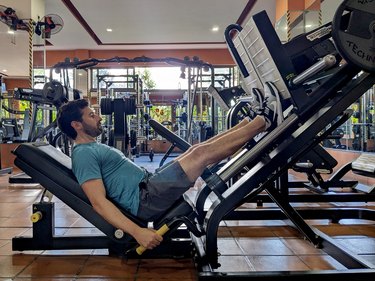
1. Set the Safety Stops
After loading the sled with the weight for your calf raises, straighten your legs to move the weight beyond the machine's locks. If you're performing calf raises with only a soft bend in your knees, you can keep these locks on and still perform the move — that way, if your feet slip, the sled won't come crashing down on you.
If you're doing the move with bent knees, Nobbe says, take the time to set the safety stops first. Most leg press machines have stops that can be set so that if the sled goes below a certain level, it will stop. If you don't know how to do this yourself, ask a staff member from your gym to help.
2. Hang About One-Third of Your Foot Off the Foot Plate
When many people calf raise on the leg press, they put just their toes or the balls of their feet on the foot plate, Nobbe says. This puts your feet in a position where they could slip.
Instead, hang just about one third of your foot — your heel, plus a little more — off the base of the foot plate. This can make you less likely to have an accident.
3. Consider Performing One Leg at Time
For an additional bit of safety, Pignataro suggests doing calf raises with one leg at a time. The other leg, he says, can hover above the plate to "catch" it if your working leg slips.
If you perform the move with one leg at a time, he says, don't put the working leg in the center of the foot plate. Keep it in the normal position, as if you were using both feet at once.
4. Flex Your Ankle Toward Your Shin and Knee
To maximize the challenge, Pignataro says, dorsiflex your ankle in this way on each rep. Since your leg isn't as strong here as it is on your tip-toes, you'll develop more strength and more muscle by increasing your range of motion in this way.
